The Neuroarchitecture Technology of Vinci Power Nap: A Revolution in Fast Stress Reduction, Newborns Protection, Well-being and Sleep Regeneration also for People with Trauma, Depression and PTSD in Smart Cities
Article Information
Magdalena Filcek *
Specialist Neuro-architecture, Master of Architecture Interior Design at Academia of Fine Art, innovator of many patented projects as innovative system Vinci Power Nap® - Dream’s Space® and the Balonodrom Project©, scientist, pilot of hot air balloons. Wroclaw, Poland
*Corresponding Author: Magdalena Filcek. Specialist Neuro-architecture, Master of Architecture Interior Design at Academia of Fine Art, innovator of many patented projects as innovative system Vinci Power Nap® - Dream’s Space® and the Balonodrom Project©, scientist, pilot of hot air balloons. Wroclaw, Poland
Received: 28 February 2022; Accepted: 07 March 2022; Published: 29 March 2022
Citation: Magdalena Filcek. The Neuroarchitecture Technology of Vinci Power Nap®: A Revolution in Fast Stress Reduction, Newborns Protection, Well-being and Sleep Regeneration also for People with Trauma, Depression and PTSD in Smart Cities. Journal of Psychiatry and Psychiatric Disorders 6 (2022): 061-104.
View / Download Pdf Share at FacebookAbstract
The article presents the benefits of the interdisciplinary science behind the revolutionary designed neuroarchitecture system and its role in improving the quality of life and well-bing of inhabitants, leaders, heroes, astronauts, on the example of Vinci Power Nap® - Dream’s Space®. The author examines its impact on reducing stress and anxiety levels, helping to prevent and treat depression, trauma and PTSD, also as a tool to support health, sleep, relaxation, alertness, increase productivity, education, focus, sense of safe and happiness, based on wide-ranging, multidisciplinary, objective and subjective in-depth pilot studies on traumatized people and surveyed groups of stressed corporate employees, international students and people with depression from psychiatric clinic. Research shows that this type of design can create a microgravity experience and also relaxing the Zero Gravity Position with gravitational pressure on the skin, which together with the force of inertia and harmonic oscillation motion create aid for the patency of the lymphatic system and can be helpful in protection of newborns from cot death. A specially designed environment allows all six senses to be soothed simultaneously, helping to ensure calm and balance in homeostasis, allows in natural way to lower cortisol levels, increase oxytocin, serotonin, vagus nerve activity, etc, leading to the fast mental and physical regeneration, also improving the immune system.
Keywords
Neuroarchitecture Space; Stress Reduction, Trauma; Depression; PTSD; Cot Death; Regeneration; Microgravity; Immune System; Well-being
Neuroarchitecture Space articles; Stress Reduction articles, Trauma articles; Depression articles; PTSD articles; Cot Death articles; Regeneration articles; Microgravity articles; Immune System articles; Well-being articles
Neuroarchitecture Space articles Neuroarchitecture Space Research articles Neuroarchitecture Space review articles Neuroarchitecture Space PubMed articles Neuroarchitecture Space PubMed Central articles Neuroarchitecture Space 2023 articles Neuroarchitecture Space 2024 articles Neuroarchitecture Space Scopus articles Neuroarchitecture Space impact factor journals Neuroarchitecture Space Scopus journals Neuroarchitecture Space PubMed journals Neuroarchitecture Space medical journals Neuroarchitecture Space free journals Neuroarchitecture Space best journals Neuroarchitecture Space top journals Neuroarchitecture Space free medical journals Neuroarchitecture Space famous journals Neuroarchitecture Space Google Scholar indexed journals Stress Reduction articles Stress Reduction Research articles Stress Reduction review articles Stress Reduction PubMed articles Stress Reduction PubMed Central articles Stress Reduction 2023 articles Stress Reduction 2024 articles Stress Reduction Scopus articles Stress Reduction impact factor journals Stress Reduction Scopus journals Stress Reduction PubMed journals Stress Reduction medical journals Stress Reduction free journals Stress Reduction best journals Stress Reduction top journals Stress Reduction free medical journals Stress Reduction famous journals Stress Reduction Google Scholar indexed journals Trauma articles Trauma Research articles Trauma review articles Trauma PubMed articles Trauma PubMed Central articles Trauma 2023 articles Trauma 2024 articles Trauma Scopus articles Trauma impact factor journals Trauma Scopus journals Trauma PubMed journals Trauma medical journals Trauma free journals Trauma best journals Trauma top journals Trauma free medical journals Trauma famous journals Trauma Google Scholar indexed journals Depression articles Depression Research articles Depression review articles Depression PubMed articles Depression PubMed Central articles Depression 2023 articles Depression 2024 articles Depression Scopus articles Depression impact factor journals Depression Scopus journals Depression PubMed journals Depression medical journals Depression free journals Depression best journals Depression top journals Depression free medical journals Depression famous journals Depression Google Scholar indexed journals PTSD articles PTSD Research articles PTSD review articles PTSD PubMed articles PTSD PubMed Central articles PTSD 2023 articles PTSD 2024 articles PTSD Scopus articles PTSD impact factor journals PTSD Scopus journals PTSD PubMed journals PTSD medical journals PTSD free journals PTSD best journals PTSD top journals PTSD free medical journals PTSD famous journals PTSD Google Scholar indexed journals Cot Death articles Cot Death Research articles Cot Death review articles Cot Death PubMed articles Cot Death PubMed Central articles Cot Death 2023 articles Cot Death 2024 articles Cot Death Scopus articles Cot Death impact factor journals Cot Death Scopus journals Cot Death PubMed journals Cot Death medical journals Cot Death free journals Cot Death best journals Cot Death top journals Cot Death free medical journals Cot Death famous journals Cot Death Google Scholar indexed journals Regeneration articles Regeneration Research articles Regeneration review articles Regeneration PubMed articles Regeneration PubMed Central articles Regeneration 2023 articles Regeneration 2024 articles Regeneration Scopus articles Regeneration impact factor journals Regeneration Scopus journals Regeneration PubMed journals Regeneration medical journals Regeneration free journals Regeneration best journals Regeneration top journals Regeneration free medical journals Regeneration famous journals Regeneration Google Scholar indexed journals Microgravity articles Microgravity Research articles Microgravity review articles Microgravity PubMed articles Microgravity PubMed Central articles Microgravity 2023 articles Microgravity 2024 articles Microgravity Scopus articles Microgravity impact factor journals Microgravity Scopus journals Microgravity PubMed journals Microgravity medical journals Microgravity free journals Microgravity best journals Microgravity top journals Microgravity free medical journals Microgravity famous journals Microgravity Google Scholar indexed journals Immune System articles Immune System Research articles Immune System review articles Immune System PubMed articles Immune System PubMed Central articles Immune System 2023 articles Immune System 2024 articles Immune System Scopus articles Immune System impact factor journals Immune System Scopus journals Immune System PubMed journals Immune System medical journals Immune System free journals Immune System best journals Immune System top journals Immune System free medical journals Immune System famous journals Immune System Google Scholar indexed journals Well-being articles Well-being Research articles Well-being review articles Well-being PubMed articles Well-being PubMed Central articles Well-being 2023 articles Well-being 2024 articles Well-being Scopus articles Well-being impact factor journals Well-being Scopus journals Well-being PubMed journals Well-being medical journals Well-being free journals Well-being best journals Well-being top journals Well-being free medical journals Well-being famous journals Well-being Google Scholar indexed journals
Article Details
1. Introduction
Following the words of Leonardo da Vinci "simplicity is the ultimate sophistication” the Author created the advance science technology by innovative sophistication connection of the simplest law of nature to recover well-being and increase human immunology health. This body and mind well-being is very important not only for individual human but especially for the heroes among us, like: leaders, doctors, soldiers who's ability to make accuracy decisions can influence millions of people, the same when consider the long-term space missions to the Mars - it is essential for crew members to achieve its goals successfully and arrive in their good health conditions. In intensive work conditions of everyday life, experiencing illness, also during the pandemic lockdown, as well as isolation in spacecraft during trips - coping with stress is crucial to preserve one’s physiological, mental and emotional stability.
The mental health effects of the pandemic that follow two years of fear of touching and escalating loneliness are visible, the nervous system is not adapted to sustain this fear and excessive vigilance that lead to trauma, depression and PTSD. There is a global need for a tool for PTSD reversal and serious somatic treatment.
The experience of stress is a biological „fight-flight-freeze” response for demanding and unexpected life situations, which cause the body to release hormones such as cortisol, osteocalcin and adrenaline [1], those hormones help prepare the body to take action [2, 3], but prolonged exposure of it can manifested of overload and physical, psychological tensions [4]. Many people in the modern world have over-stimulated nervous systems and become desensitized to chronic stress. Over time, this can lead to low vagal tone, which has been linked to a variety of physical health issues, including chronic inflammation, neurodegeneration, poor gut and cardio-vascular function, autoimmune diseases and cancer” said Dr. Navaz Habib. It can lead to: heart attack, stroke, high blood pressure, diabetes, obesity, a weakened immune system, sexual dysfunction, histamine intolerance [5] gastrointestinal disorders, respiratory infections, insomnia, and poor body-brain communication [1, 6, 7], burnout which together with other triggers could lead also to mental problems or illness, according to the National Alliance on Mental Illness, approximately 1 in 5 adults in the U.S. (43.8 million, or 18.5%) experiences mental illness in a given year [8], the rates of which are even higher due to chronic sleep loss caused by stress [9].
Leaders, decision-makers across a broad range of situations (many of which involve the protection of human life and property, including aviation, air traffic control, ship navigation, health care, emergency and crisis response, military command and control operations and every person [10]), are not immune to the everyday emotional distress, sleep deprivation, sensory, muscle and mental fatigue, experiencing: huge stress, irritability, difficulty sleeping, anxiety, etc., which could lead to inability to perform well with efficiency and chronic stress with time can develop depression and PTSD [11]. There are number of strategies which can help to reduce overwhelming stress levels and improve well-being [12].
In this pilot study are investigated the beneficial role of the interdisciplinary technology system of neuroarchitecture using example of the Space/Vinci Power Nap® on the potential reduction of levels of stress, pain, anxiety, insomnia, depression, PTSD, and any positive impact on health, relaxation, well-being, productivity, learning, refreshed mind, feeling safety and happiness. Based on small but very deep multidisciplinary objective and subjective studies on 2 women with trauma, 1 man soldier who is veteran with PTSD and on a different fields group of hard mental work people: included 41 employees of the 3M corporation, 18 international students from Henley Business School from the UK and people with depression from Psychiatric Clinic of the University Clinic Hospital in Wroclaw, who filled the survey. The author is collecting and provides results from research from basic neurobiology and neuropsy-chology responses to the designed environment with proposed solutions from physics, that will help understand and support increasing human health, also by better design of architecture, rising quality of life and performance here on Earth in smart cities and in the Space.
This study is providing the understanding and foundations of much subsequent clinical research in managing stress and regeneration thanks to this technology as an example of resilient and responsible architecture, with specially designed green interior environment created to alleviate the disadvantages of modern cities making them future smart cities. Analyzing data from this study what aspects of environment could be important to reduce stress people experience in smart cities, we can use the electronic methods and sensors to collect data and in-sights from citizens, devices, buildings and assets, to process and analyze them to manage creation of much smarter sensory sustaina-ble environment, which will be better for human health in a devel-oped urban area which can become more 'liveable' and resilient.
2. Neuroscience of Stress, Sensory Overload and Sleep Lost
2.1 Chronic stress in modern, industrial cities
Lots of factors can trigger a stress response, especially while living in an urban environment, including: dangerous situations and psychological pressures, such as work deadlines, financial difficulties, exams, accidents, difficult relationships, loss of a loved one. There are also biological stressors like: inadequate diet which can make histamine release causing chronic multi-organs inflammation, insufficient sleep or exercise, exposure to specific environmental somatosensory stress triggers: overwhelming noice, visual, tactile, olfac-tory and other stimuli, pollution, allergens, and extreme heat or cold (leading also to mast cells activation leading to histamine intolerance) [13].
Signs and symptoms of chronic stress can include: irritability which can be extreme, fatigue, headaches, difficulty concentrating or an inability to do so, rapid disorganized thoughts, difficulty sleeping, digestive problems, changes in appetite, feeling helpless, a perceived loss of control, low self-esteem, nervousness, frequent infections or illnesses [2]. This is also due to unbalance of homeostasis straining of the sympathetic and parasympathetic systems, which - together with the somatic system and vagus nerve - form the autonomic nervous system [14].
2.2 Impact of senses and sleep on human performance
The senses are like a window to the world. They enable conscious life, allow us get to know the environment, feel it and understand it [15]. In science, this is called sensory perception of: sight, hearing, smell, taste, touch, somatic senses (nerve signals from the skin, muscles, joints with their sensory receptors) and magnetoception [16]. Each type of sensory perception is represented in the appropriate area of the cerebral cortex to which the streams of nerve impulses flowing from the receptor are directed [17]. In human body are different types of neurons, including those that respond to external and internal stimuli; when a neuron transmits a signal, it sends the electrical impulse and neurotransmitters like: oxytocin, dopamine, serotonin, noradrenaline, vasopressin allow two neurons to communicate with one another [18]. Patterns of neuronal activity (oscillation) are associated with specific senses, behaviors and feelings [19].
“Human senses can handle more than 11 million bits/s: 10 million are processed by the visual system; ~1 million via the ears; 10,000–100,000 via the skin; much fewer by the olfactory system and remaining sensory channels (gustatory and vestibular). Only a minuscule proportion of sensory data (~50 bits/s) is processed by the conscious mind; remaining data are processed unconsciously; that is ~220,000 (11,000,000/50) times as many as data processed consciously. The insular cortex particularly receives sensory inputs from both interoceptive and exteroceptive sources and integrates these multimodal signals” [20]. Perceptual disturbance can be created by heavy workloads, overwhelming stress and environmental pollutions, leading to over-activation of our neurons which in turn can cause harmful anxiety and stress, cognitive discomfort, disruption of interaction with the environment, problems with memory, thinking, decisions. Also emotions, like: joy, happiness, as well as pain, fear and sadness can be triggered by senses [21]. The environmental factors such as temperature (uncomfortably cold, warm or vibrations), noise, elevated CO2 levels, amount and timing of ambient light, electrosmog and others pollutions also interfere with human health, mood and sleep maintenance [22-26].
It is well established that sleep loss is associated with poor health and performance decrements. Perception is occasionally impaired spontaneously, especially when one is tired, evidence report from NASA human research: “Risk of performance decrements and adverse health outcomes resulting from sleep loss, circadian desynchronization, and work overload in human health and performance risks of space exploration missions” [27].
As we know from scientific research and personal evidence, tiredness and fatigue were identified as one of the primary factors in accidents attributed to human error: a study (2001) in the British Medical Journal, showed that sleep deprivation in doctors doubles error rates [28]. “Driving while tired is as dangerous as drink-driving, all aspects of our self, all abilities deteriorate when we stay awake" says Mark Rosekind from the US National Highway Traffic Safty Administration [29]. According to the US Center for Disease Control and Prevention report, 11,7% of drivers of 18 - 34 age fell asleep behind the wheel in the month preceding the study. 60% of respondents by the National Sleep Foundation admitted that they had driven their car being in a state of sleeplessness in the last year, researchers from the US Federal Aviation Administration (March 2005) found that American air traffic contenders sleep an average of 5.8 hours a day, and in the case of night monitors, only 3.25 hours; of those who made mistakes at work that could have a negative impact on safety, 56% explained that they were tired [30].
2.3 Sleep deprivation and important role of NREM sleep in brain cleaning
Sleep is an extremely important aspect of everyone's life. High quality of sleep is the basic element of regeneration, which translates into the efficiency of the body's functioning during the day, health and longevity [31, 32]. Optimal night rest allows for tissue regeneration and stress reduction, it influences the secretion of hormones, maintains appropriate amounts of brain wave and synapses activity, regeneration of cells, muscle rebuilding, has a positive effect on the immune system, memory association and its implications on cognitive tasks performances, the ability to learn, alertness, concentration, health, happiness and overall well-being [33, 34]. Undisturbed sleep is also very important for NREM stage where slow waves oscillations occurs (delta brain waves) [35]. Professor Angst of the University of Zurich showed through many years of studies that poor sleep (insomnia) eventually results in the change of appearance can lead to emotional shifts, clinical depression or anxiety (as well as other psychiatric conditions) and vice versa - sleep disorders are one of the core symptoms of depression [36, 37] “The relationship is bidirectional — depression can precede insomnia” said Rachel Manber, a professor in the psychiatry and behavioral sciences department at Stanford. Dr M.Walker professor of psychiatry at Harvard and Berkeley University [38] have found more precise insights into the nature of nap and sleep dependent, memory consolidation at an anatomical, physiological, and behavioral level. Alludes habitual disruption of natural restorative function of phasic REM and NREM sleep processes also by stress associated with traumatic events, like: combat, bereavement, divorce, child abuse, neglect or chronic drug abuse, as well as depression, PTSD and alcoholism [39, 40]. The human nervous system is not always able to integrate difficult experiences, in order to survive, the body often displaces them or enters the flight phase to protect itself from experiencing too much suffering, this is the way stress and trauma build up in the muscles causing chronic pain and tension which also can not allowing to sleep properly [41]. In the long term chronic disruptions in slow wave sleep have been shown to increase the risk for development of Type II diabetes [42] insulin resistance, hypertension, obesity [9], to produce measurable effects on mood and cognition, as sleep slow wave activity is beneficial for memory consolidation and task performance optimization [43, 44]. From study of neuroscientist Laura Lewis of Boston University we know that deep sleep can give the brain a deep clean, as "slow-wave activity during dreamless slumber helps wash out neural detritus and regulate HRV. The accumulation of amyloid beta (Aβ) in the prefrontal cortex is associated with the disruption or reduction of slow waves of NREM sleep, and can create: neurological disorders: Alzheimer's disease (AD), Parkinson’s disease (PD), Charcot–Marie–Tooth disease (CMT)” [45]. What is important persons suffering from depression and PTSD show a lower amplitude of NREM [39, 46, 47].
Notable is the fact that newborns’ human brains occupy the majority of their time asleep in NREM (delta waves) and they learn at a very fast rate and then shows a linear decline in amplitude across the adult lifespan [48]. “Essentially, with age (…) you get less quality deep sleep, and have less opportunity to consolidate new memories” said Dr. M.Walker [49]. Slow-wave sleep is necessary for survival [50], the absence of this element causes a number of physiological and mental problems like: depression, apathy, headaches, dizziness, attention disorders, fibromyalgia and chronic fatigue syndrome with multiple tender points, etc. following American Academy of Sleep Medicine (AASM) [51]. That is why it is so important to create a safe, stress free space in which person will be able to release the tension, sadness and despair that have accumulated in the body, to „unlock or process the traumatic memories”, which in result allows for nap or good night sleep and recovering [52]. As research showing that sleep therapy for people with depression could double their chance of a full recovery [53].
3. The Science Behind Good Sleep- The Technology of Neuroarchitecture - Space/Vinci Power Nap® System
The wisest and noblest teacher is nature itself” - Leonardo da Vinci (1452-1519)
"Neuroarchitecture" - author's special interior environment, designed with neuroscience knowledge, which has a calming effect on all senses (smell, sight, hear, touch, taste, balance, magnetosensory) at once, to reduce stress and calm down the nervous system, regenerate both body and mind, because the environment human stays is the biggest factor for triggers changes in his health and life [54]. “Many trauma survivors hold their breath and their bodies tightly, bracing themselves for whatever is coming next. Staying alert for years takes a tool. Create spaces where You can take Your armor off” - Dr Thema.
This innovative system has already been used for: children in a school, UN delegates at the CCC, groups of soldiers and pilots, for future astronauts in a habitat - successfully helped to refresh the mind, body and efficiency. The results indicate the advisability of implementing this solution also in hospitals and clinics to reduce stress for doctors and patients, as well in other important places in smart cities, to create a better and healthier future for citizens. And in the future in spaceships for astronauts and in habitants on the Moon or Mars.
3.1 The power of 20 min naps regeneration - for successful leadership
“A quick 20 min power nap during the day can do wonders for your mental and physical stamina especially when fatigue sets in” said Dr. James B. Maas. Dr. Mark Rosekind with NASA’s pilots study has shown that optimum maximum time for napping is 26min, during it increasing: energy and refreshment of the mind, performance by 34%, creativity by 40%, overall alertness by 54%, memory and learning, greater concentration, productivity and efficiency in a range of contexts [55, 56]. Moreover, napping 3 times a week leads to 37% lowering of the risk of death from heart disease and reducing stress levels and can prevent burnout [57], considering information from Sleep Foundation: "take naps in a dark and quiet place with minimal distractions” [58] and N.Littlehales advices for naps [59].
"Go to bed to get ahead” - the secret to success of some of the most influential people on the planet is that they rely on the art of napping, which restores their well-being of body and mind, when they're fatigued. Nappers such as L.Da Vinci, A.Einstein, and S.Dali paved the way for others, including: W.Churchill, J.F.Kennedy, R.Reagan, N.Tesla, T.Edison, B. Franklin, N.Bonaparte, M.Thatcher, B.Clinton, E.Roosevelt, Y.Berra, etc. [60]. “Nature has not intended mankind to work from eight in the morning until midnight without that refreshment of blessed oblivion which, even if it only lasts twenty minutes, is sufficient to renew all the vital forces… Don’t think you will be doing less work because you sleep during the day. You will be able to accomplish more. You get two days in one — well, at least one and a half,” said W.Churchill [61]. Possibility to rest and regenerate body and mind by power naps is important not only for pilots, astronauts and military navigators but also while living in fast modern cities for drivers, doctors, teachers, everyone [62].
3.2 Neuroscience of forest environment and of zero gravity position
This interdisciplinary technology is an evolution of the cognitive-behavioral therapy method, it is a structured combination: exster-; intero-: pro-prioreceptive stimuli [63, 64] and embodies the "complexity of simplicity" in the proprietary Vinci Power Nap® system. It is specially designed neuroarchitecture room (Picture 1) with natural forest environment (the Japanese wellness therapy Shirin-Yoku) calming all senses at once, allowing for regenerative naps, bringing the healthiest scientific benefits for mind-body connection, regulating cardiovascular, immune systems, balancing hormones, improving mood and night sleep [65]. Leonardo da Vinci said: all our knowledge has a beginning in our senses [66]. In this study author is explore the role of VPN system in relation to overloaded by the civilization the “proprioreceptors”, by designing soothing the senses: hearing - creating silence from outside noise together with surround or binaural sound with a specially composed soundtrack with obligatory natural bird singing (it is proven that sound of birds's singing gives the sense of safety, because birds are not singing when danger is near), eyesight - delicate light and calming green color of birch forest, smell - fragrance of freshly cut grass, fresh purified air with more oxygen, taste - strengthening of birch juice, touch - stepping on the grass without shoes, optimal temperature, pressure of the hug of the cocoon, proprioception - stimulation from body’s position while in motion.
A key component to this is also equilibrioception - stimulation of the inner ears of the vestibular system [67, 68], achieve by the body swinging in the VPN pendulum, creating for the first time on Earth - Zero Gravity Position (ZGP) by using special natural but stretching material. This position activates relaxing diaphragmatic breathing (the rhythm of breathing creates electrical activity in the human brain that enhances emotional judgments and memory recall, when person inhale, in a sense it is synchronizing brain oscillations across the limbic network [69]). The swing motion stimulates the vestibulo-ocular reflex (EMDR therapy) [70], and the vagus nerve, which is mediating between nervous system and immune system (connected physically and psychologically) to maintain their balance, as there is no robust immune system without healthy nervous system [71].
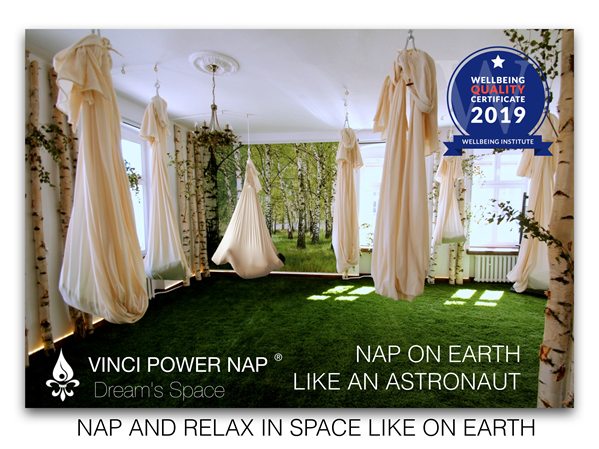
Picture 1: Interior of forest Vinci Power Nap® with zero gravity position on Earth.
From NASA studies ZGP is the body’s natural resting position (picture 2), and it affords exceptional "relief from lower back stress while also placing heart on equal plane with body mass, thereby minimizing the effort required to pump blood throughout the body. Relieving: stress, high blood pressure, muscular and chronic pain, headache, jet lag, insomnia, back pain, depression and anxiety” [72].
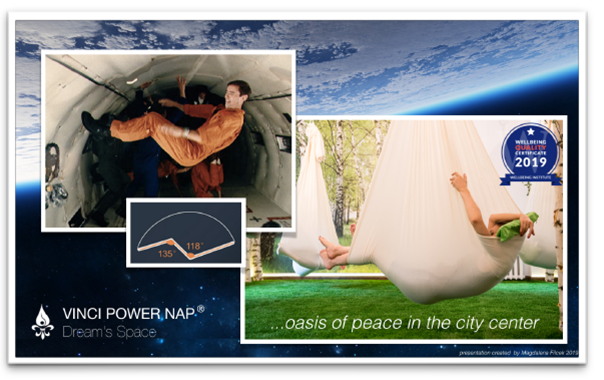
Picture 2: Zero gravity position first time created on Earth in VPN.
3.3 VPN technology as a generator of oscillation
The author had made research that swinging in the VPN pendulum (almost like the heart of the bell) - creates feeling of weightlessness and simulation of hyper-gravity from 1,49G to 0,7G microgravity on Earth, with oscillation of slow wave frequency 0,618Hz. This value is similar to delta waves frequency which occurs in NREM deep regenerative night sleep and also to the golden ratio number, which appears also in Fibonacci numbers proportion and was observed by scientists in nature [73].
The author is putting the hypothesis that creation of pulsating pneu-matic hugs of cocoon which oscillation of 0,618 Hz together with whole VPN system can also generate a calming natural environment in spaceship for overwhelmed astronauts, with benefits for their immune system. Following the countless studies about efficacy decreasing people’s stress by the view of nature scenes, could be even more powerful for mental health of people up in space [74].
The swinging motion itself can lead to increase: happy mood, feelings of calm and safety, better neurocepction by soothing senses and rest, focus and attention, awareness of vestibular system (body location in space), balance and coordination, spatial awareness also lowering stress hormone [75, 76]. Swinging in VPN cocoon reminds swinging like in their loving mother's arms, likely creates the safest space to reduce trauma symptoms, to recharge, regenerate and reconnect. VPN generator of oscillation has been implemented in habitat on Earth for future astronauts training in the analogue missions. The research how this generator of oscillators, allowing also for power naps, is helping people who are lock for 7 days in special simulating ISS environment was done in May and June 2021 with great success, the data and results will be publish soon. Vinci Power Nap® can create forest environment for the astronauts in Space to keep them emotionally tethered and connected to Mother Earth [73]. To check the impact of neuroarchitecture on human health and performance - there are plans to arrange the whole VPN system in the habitats and provide next science research to explore how beneficial this technology can be for physical and mental health of future astronauts, during long isolation. Space Power Nap® - Dream’s Space® could create the Overview Effect [77], the view which astronauts have from the spaceship, for people on Earth to let them feel the fragile of our planet seeing her from above while being in zero gravity position surrounding by simulation of space.
3.4 Pressure, microgravity, hypergravity as the benefits for immune system
NASA experiments shows that un-refreshing or non-restorative sleep alters immune function, by reducing NK cell (Natural Killer cell) counts [78]. “The links between the psychological and physiological features of cancer risk and progression have been studied also through psychoneuroimmunology [79]. The persistent activation of the hypothalamic-pituitary-adrenal (HPA) axis in the chronic stress response and in depression probably impairs the immune response and contributes to the development and progression of some types of cancer” [5]. A vital part of immune system - protecting the body from external threats, such as: infections, bacteria, disease, damage, inflammation, and cancer cells - helping to maintain fluid balance are also: the lymphatic and glymphatic system, endolymph and interstitum [80, 81]. Knowing from science research that the most beneficial way to keep the lymphatic system running smoothly is movement, autor notice that VPN system can deliver significant help for it by the motion of the pulsating rhythm of pendulum, which also allowing to experience: „at the highest point of the swinging person is weightless (microgravity) the cells stretch and absorb the water from the tissues, when landed (hypergravity), the cells compress and excess fluid from them is forced into the lymphatic system” [82] (picture 3).
This can help in cleanse and strengthen the immune system, and at the same time: harmonize heart function, deeply relax stressed bodies from physical and emotional tensions in Zero Gravity Position (ZGP) and regenerate one’s mind during a slow wave nap [73], what can leads to needed relieve and preparing body to faster falling asleep during the night.
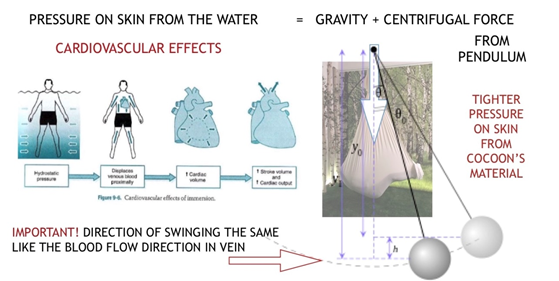
Picture 3: The healing power of swinging and touching - the pressure on skin [83].
The promising new experiments reveal also that “Microgravity Seems to Neutralize The Majority of Cancer Cells” [84-87], and another research on cancer and longevity [30] also will be studied with hyper-gravity [88], giving hope for additional advantages of this technology, as the study performed by PhD Kelly Turner shows that releasing trauma and emotional stress from the mind and body can be a key component of healing and can have incredibly powerful consequences in spontaneous remission from terminally ill cancer patients [89]. The connection of our mind and body is well documented [90, 91]. "A better understanding of the bidirectional communication between the neuroendocrine and im-mune systems could contribute to new clinical and treatment strategies” [5, 92], also bringing improvements in designing the healthier architecture for smart cities.
4. Natural Ways to Increase Oxytocin, Serotonin, Melatonin
Traumatic experiences (also from Covid-19 pandemic lockdown), regarding threats to one’s health and life, disrupting sense of safety can lead to: feelings of loneliness, frustration, anxiety, depression, inducting PTSD. Scientists have found that not only lack of sleep, but also stress from isolation is damaging to mental health and physical health as well, especially our immune systems [93]. Technology makes it easier than ever to keep in virtual touch with others and it might actually help you fight off viruses, but what about real touch?
The paradox of the situation of Covid-19 isolation, is that people need touch and hugs as often as possible when they are scared; in fear and anxiety contact with another person soothes „hugs, cuddling, touching works as an antidepressant” [94]. Long pressure during hugs on big part of skin stimulates neurotransmitters together with Ruffini and Pacini receptors which active production of endorphins, dopamine, oxytocin and then serotonin - hormones which give feelings of bliss, safety, love, happy mood and also helping to produce melatonin by synthesizing serotonin - what leads to better quality night sleep and regeneration of brain and body [65, 73]. This stimulation is very important for health, well-being and better sleep.
4.1 Relationship between oxytocin, health and sleep quality
The neuropeptides oxytocin and vasopressin were isolated and synthesized by Vincent du Vigneaud at Cornel Medical College in 1953, for which he received the Nobel Prize in Chemistry in 1955. Oxytocin is produced in neurons to act as a neuromodulator with widespread central effects [95]. Recent years dramatically increased the interest of scientists in oxytocin as it has been found to have many positive physiological, psychological and social behavior effects [96].
Its correct level helps to reduce not only the time to fall asleep, improves sleep quality, increases the number of REM episodes and regulates the circadian rhythm, but also shows beneficial antistress, has anxiolytic effects by regulating the hypothalamic-pituitary-adrenal axis (HPA) and the activities of the amygdala (by its projection into the brainstem and hypothalamic centers, reduces endocrine and psychological responses to social stress [97]), it reduces sympathetic nervous system activity “fight or flight”, and increases parasympathetic nervous system activity “relaxation & growth”, “calm & connection” [98, 99].
Oxytocin (OT)-secreting system (OSS) plays an essential role. The OSS, consisting of OT neurons in the supraoptic nucleus, paraventricular nucleus, their several accessory nuclei and associated structures, can integrate neural, endocrine, metabolic, and immune information and plays a pivotal role in the development and functions of the immune system. The OSS can promote the development of thymus and bone marrow, perform immune surveillance, strengthen immune defense, and maintain immune homeostasis. Correspondingly, OT can inhibit inflammation, exert antibiotic-like effect, promote wound healing and regeneration, and suppress stress-associated immune disorders.
In this process, the OSS can release OT to act on immune system directly by activating OT receptors or through modulating activities of other hypothalamic–pituitary–immune axes and autonomic nervous system indirectly. The OSS plays a key role in the neuroendocrine–immune net-work. It not only has direct regulatory effects on the development and functions of the immune system but also exerts functions of immune defense and homeostasis through coordinating the activity of the whole neuroendocrine–immune network as well as peripherally produced OT” [100].
Oxytocin suppresses negative emotions, inhibits cortisol re-lease, reduces: the level of stress, mental tensions, inner fear and social anxiety, pain [98], blood pressure, helps overcome phobias, improves intestinal peristalsis [101] and promotes faster wound healing in people (decreasing certain cytokines [99, 102]), increases feelings of calmness and security, has a role in various behaviors: social recognition, adaptation processes, increasing confidence, overall wellbeing [103]. This hormone is necessary for creating and shaping human relations, it not only determines the relationship between the child and the mother, but also affects the feelings of closeness and attachment between partners, as level of oxytocin rises when they touch, kiss and hug each other, it strengthens the bond, a sense of intimacy, trust and closeness, called the „ love hormone” [103]. It helps in developing pregnancy, maternal behaviors for woman and man, and any stress response in children is mitigated by the touch or voice of the mother [104], in male reproductive physiology (playing a role in inducing erections in sperm release, its movement (transport) and production of testosterone by the testes [105, 106]).
“Oxytocin functions like a system activator and often influences the release of other signaling substances such as opioids, serotonin, dopamine, and noradrenaline. Through these activations, different behavioral and physiological effects are facilitated and coordinated into adaptive patterns, which are influenced by the type of stimuli and environmental factors” [107]. That is why the whole elements of neuroarchitecture of Vinci Power Nap system are design with special awareness, every detail of the whole system is very important and play key role in this activations. The impact of it is exploring by the author in this research.
4.1.1 Like in the mother's womb - the healing power of swinging and touching
The higher pressure in the mother’s uterus, stimulates the brain differently thought the mechanoreceptor of the skin” [108]. Unfortunately, atmospheric pressure does not generate the same sensory stimulation after birth and levels of hormones are changing [109, 110]. “The gentle birthing techniques is the practice of im-mersing newborn infants in a small tub of warm water - known as a "Leboyer bath” - to help ease the transition from the womb to the outside world, in low lighting and quiet in a warm room to limit the supposed shock of birth, and that a newborn be laid on its mother's stomach and allowed to bond, instead of being taken away for tests” [111] so close to vision of Jacques Mayol in his book„ Homo Delphinus”, and Michel Odent, who became known for introducing birthing pools in hospitals.
Being in skin-to-skin contact with the mother after birth elicits the newborn infant's internal process; is suggested it contributes to the early coordination of the infant's five senses, as well as movement and it also increases levels of oxytocin [112, 113]. Dolen et al. found that that oxytocin acts by increasing serotonin and modulating the serotoninergic system [88, 114]. It has also been proven that microinjection of oxytocin to brain structures reduces the response to stress stimuli [115] but synthetic oxytocin does not penetrate the blood-brain barrier [116]. There is a question how to produce own natural oxytocin, serotonin and reduce cortisol, adrenaline, and also integrate the senses? The answer can be in VPN (picture 4).
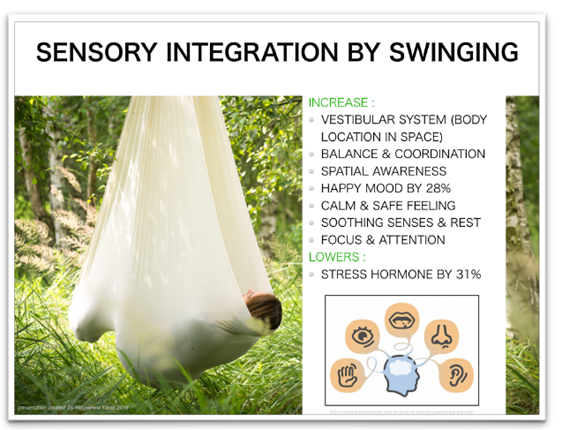
Picture 4: Sensory integration by motion, swinging like in mother’s arms [117].
The central release of oxytocin and serotonin, and its positive effects, may be modified by environmental factors [118, 119]. Maybe special VPN cocoons (created for adults and for children) and their stimulation of oxytocin-related receptors by pulsating pressure of touch of elastic material (safe hugs not-human connected) and rocking in silent, safe environment calming senses, can be the helpful to decrease symptoms of depression of new parents and probability of Autistic spectrum from first days of new born babies [120, 121]. What is important, latest research of Dr Bright from University of Adelaide, published in the Journal of Neuropathology and Experimental Neurology has confirmed the findings of the American research concept that abnormalities in serotonin in the brain are most definitely linked to cases of SIDS (to sudden infant death syndrome) [109, 110], that is why mini VPN for infants, with slow-wave frequency swinging motions, probably could also be a helpful tool for prevention of cot death (infants have been shown to spend a most of time in slow-wave sleep, and thus have more delta wave activity, in fact„ slow-waves are the predominant wave forms of infants” [122]).
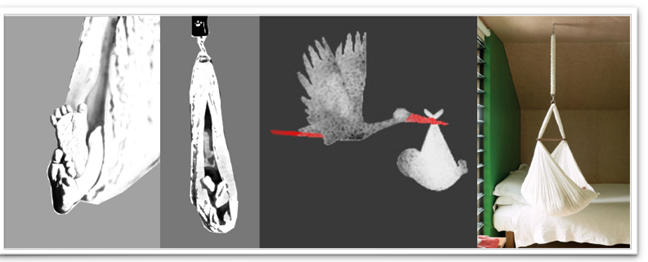
Picture 5: Mini Vinci Power Nap® for infants, similar to traditional Malaysian and Singaporen Duyan / Sarong Buaian [123] last picture, and also Polish traditional story of the stork bringing children wrapped in fabric [124].
“Deep touch experienced in VPN, a strong hug with pressure exerted on the largest body surface possible at a time, warmth and stroking by air during gravity swinging alleviates sensory system dysfunctions, it relaxes, regulates heart rhythm and muscle tone, is pleasant, gives a sense of security and inner peace. Children that are rocked, swung and subjected to massages are calmer and grow faster [125]. Orphans who did not have parents and were not swinging as much as they needed, rocked themselves while sitting when they able to do it, as their brain need it to grow and make connections of the body with senses [126]” [65].
The author invited 15 orphans to VPN, it was in the same time the most sublime feeling and heartbreaking experience as, they fell asleep immediately and noted after the session, that they never felt so loved as in these cocoons. VPN system is giving the very similar feelings like in mothers womb. Placing babies in material (sarong cloth) like in hammock (but swings up and down with a special spring) have been found in Malayzia/ Singapore tradition. It has been proven to be effective can help calm the baby and is one of the ways to stimulate the vestibular senses (balance and movement) that are important for a child's growth motor skills. The position in cocoon can give the baby the feeling of moving and learning to balance the body every time it moves [127, 123].
The same VPN cocoons for adults, by increasing oxytocin activating serotonin and the connectivity of the amygdala with the prefrontal cortex of the cerebral cortex, stimulating parts responsible for planning, predicting, remembering, emotions and inhibiting drives [128] which could be helpful to decrease addictions, depression, trauma and PTSD. People feel depressed and have addictions also because they feel unloved and unwanted (nor accepted), this feeling is connected with low levels of neurotransmiters and the person is unconsciously "hungry" for them, easily become frustrated, aggressive and stay longer in toxic relationships because of promises of "oxytocin touch", so needed to survive [129]. In this research the autor is exploring if using the technology of neuroarchitecture VPN can help to increase this hormone naturally in human body.
4.2 Serotonin - the "happiness hormone”
Serotonin, otherwise known as 5-HTP and the „happiness hormone”, is a neurotransmitter derived from the amino acid tryptophan, found in different parts of the human body, including the central nervous system. Among its many roles, serotonin is involved in the regulation of sleep, rest, the cardiovascular and respiratory systems, chemosensitivity, thermoregulation, arousal, sexual needs and pain sensitivity, etc. [130]. It is a key factor in maintaining feelings of joy, happiness and contentment. In the brain development, serotonin 5-HTP neurotransmitter performs a central role in stress reactivity, mood regulation disorders of psychiatric risk factors (impulsiveness and aggressiveness), fatigue, intercession of cognition [131]. As serotonin is the precursor to melatonin its lack in the body could lead to poor night sleep not allowing regenerate the body and mind, leading also to depression [132]. Within the pineal gland, serotonin is acetylated and then methylated to yield melatonin. In this article the autor is checking if using the technology of neuroarchitecture VPN can help to increase this hormone naturally.
4.3 Melatonin - the “sleep hormone”
The serotonin/melatonin cycle is a primary physiological driver of the daily metabolic, awake/sleep cycle [133]. At night (in a good environment darkness conditions) the pineal gland’s rises output of melatonin. The pineal gland is responsible for the production of melatonin and therefore for the management of the sleep hormone (biological implications of the pineal gland (it cells are magnetically sensitive [134]) in connection to electromagnetical fields (frequency) have been researched for over 45 years [135]). Melatonin is a vital part of many of the body’s biochemical systems, including sleep, learning and is free radical scavenging in all cells and hence is a potent antioxidant with anti-aging and anti-cancer properties, mediates many hormone functions, sleep stages of REM and NREM, assists in maintaining immune system health and virus protection, its reduction can lead to adverse health effects, and shortens the time to fall asleep, increases the total sleep time and improves its quality [136]. The author is investigating if increasing of serotonin level by using VPN technology during the day can naturally help increase then melatonin and the same increase the quality of night sleep following the observations of the participants.
5. Trauma, Depression and PTSD - VPN as a New Therapy?
“Many trauma survivors hold their breath and their bodies tightly, bracing themselves for whatever is coming next. Staying alert for years takes a tool. Create spaces where You can take Your armor off” - Dr Thema.
"Our brain is the greatest supercomputer on earth. When everything is ok complex network of about 100 billion neurons, it’s great at fast processing and organizing information between 18 and 640 trillion electric pulses are zipping through the brain. This matrix carefully encodes and stores memories and experiences. Traumatic shock can cause memory processing system to malfunction: the so the traumatic memory isn’t logged and stored properly, it subvert to dissociation: memories are split into fragments, which can be hold an imprint in brain and body's cells” [137]. The body is an ever learning, adapting, renewing system of information, without proper sleep and regeneration, together with anxiety the system can break down leading to depressive symptoms [138].
5.1 Depression
Depression is the most common mental disorder, affecting some 18 million Americans in any given year, according to government figures, and more than half of them also have insomnia. After pandemics and other natural disasters the number will be much higher [139]. Sleep therapy in people with depression could double their chance of a full recovery, scientists are reporting: Colleen E. Carney said: “I think we need to start augmenting standard depression treatment with therapy focused on insomnia” [140]. Persons suffering from depression show a lower amplitude of NREM (delta slow-wave) [141, 142], as sleep disorders are one of the core symptoms of depression [143].
5.2 PTSD also in veterans
The VA defines PTSD as “the development of characteristic and persistent symptoms along with difficulty functioning after exposure to a life-threatening experience or to an event that either involves a threat to life or serious injury” [144]. PTSD can result from the experience or witnessing of military combat, a terrorist attack, violent crime and abuse, natural disasters, serious accidents, or violent personal assaults. Post-traumatic stress disorder (PTSD) is a serious physical or psychological injury leads to a host of problems including distressing, intrusive memories of the traumatic event (flashbacks), memory and concentration problems, apathy, lack of trust, irritability, anger, aggressive behavior, suicidal ideation, addictions: e.g.smoking, alcoholism and drug dependency; muscle tics, hypertension, auditory and sight losses, stomach ulcers, hair greying, alopecia, sleep disorder and nightmares [145], because the human nervous system is not always able to integrate difficult experiences. In order to survive, the body often displaces them or enters the flight phase to protect itself from experiencing too much suffering. This is the way stress and trauma build up in the muscles causing chronic pain and tension, that is why is so important to let person release the tension, stress, sadness and despair that have accumulated in the body. The therapy consists in creating a safe space in which person will be able to release what has seemed too difficult so far, from the body and mind, in natural way, "unlocking or processing the traumatic memories, releasing them from being trapped in system, allowing them for heal integration in the mind" says Harvard psychiatry professor Dr Kerry Ressler, [146]. In the book on PTSD and trauma „The Body Keeps The Score”, Dr Basel Van Der Kolk’s book outlines "both deep NREM sleep and REM sleep play an important role in how our memories change over time.” The areas of the brain involved in information processing and memory have increased brain activity during slow wave sleep [147].
Dr M.Walker professor of psychiatry at Harvard and Berkeley University [148] have found more precise insights into the nature of nap and sleep dependent, memory consolidation at an anatomical, physiological, and behavioral level, alludes habitual disruption of natural restorative function of phasic REM and NREM sleep processes also by stress associated with traumatic events (like: combat, bereavement, divorce, child abuse, neglect or chronic drug abuse) as well as depression, PTSD and alcoholism [141, 149]. Stickgold, Hobson and their colleagues research shows that the dreaming brain alters memory, deepening emotional traces of relevant information while eliminating non-essential ones. "If bilateral EMDR stimulation can alter brain state in a way similar to that seen in REM, there are Reasons why it could use sleep-dependent processes (which may be ineffective or blocked in people with PTSD) to enable effective "treatment" of memories and resolution of the trauma problem” [150-152]. Author of this article have found in her study that the VPN cocoon swings around 0,618Hz frequency (the range of slow waves sleep), this induced activity generally could reflects the activity of neurons in NREM sleep which help with deep cleaning of the brain, hormone balance, regulation of the circadian clock, together with its soothing neuroperception of senses - creating very relaxing kind of psychosensory therapy [150]. Studies from The Trauma Centre show that meditation, relaxation and physical activity also deliver real results in this release and can help the healing process of trauma [153].
While PTSD affects about eight million American adults in a given year [154], the problem is especially acute in military - among war veterans [155] where the relationship between sleep problems and suicide, "generalized sleep disturbance, insomnia, and nightmares were, overall associated with suicidal thought and behaviors” [156, 157]. An estimated 18 to 22 veterans die from suicide each day [158]. “According to a study conducted by the RAND Center for Military Health Policy Research, less than half of returning veterans needing mental health services receive any treatment at all [159]. “There is widely accepted method of treatment for PTSD like Cognitive Behavioral Therapy (CBT), but there is clearly an urgent need to identify more effective approaches for the management of symptoms, as not all patients will respond adequately to psychotherapy or evidence-based/first-line pharmacotherapy. Further understanding of the underlying physiological and neurological processes will be helpful in developing new and effective therapies to treat PTSD” [160]. The VPN sessions are very helpful in fast stress re-duction, relaxation, which can help everyone including: soldiers, pilots, astronauts, etc., as everyone deserves the opportunity to live their most fulfilled life, free from self-doubt, insecurities, psycho-logical trauma, depression, anxiety, addiction, and other painful and life-impacting struggles.
6. Material and Methods
“The initiator, executor and sponsor of the VPN interdisciplinary somatosensory research is the author of the Vinci Power Nap® system - Magdalena Filcek, MA - neuroarchitect, designer, scientist, artist, visionary, inventor and pilot of hot air balloons. The author declares no conflicts of interest; this has been an entirely her private founds and independent project.” [73].
6.1 Subjects
“In this pilot study (research) participated: man=M (soldier/veteran with PTSD, age:39), woman=W (with trauma, age:47) and the author as a control subject for oxytocin research=C (woman after trauma, age:42), and 3 very specific groups of 73 people who had given answers from a questionnaire after VPN sessions: people with depression from Psychiatric Clinic of the University Clinic Hospital in Wroclaw (14 people), international students of Henley Business School (18 people) and employees of 3M company office in Wroclaw (41people).
Informed consent was obtained from subjects. A detailed explanation of the study protocol was given to the subjects before they gave written, informed consent, according to the Declaration of Helsinki Principles.” [73].
6.2 Study-research protocol
- Laboratory INVICTA (Infertility Treatment Clinic), Gdansk, performed all blood parameters, including oxytocin and other hormones, at the request of the author of the research. Oxytocin lev-els were assessed with the help of NCalTM International Standard Kit DetectX® Oxytocin Enzyme Immunoassay Kit (1 Plate Kit Cat. Nr K048-H1 5 Plate Kit Cat. Nr K048-H5)
- Manual pressure gauge and finger pulse oximeter.
- Psychologist Agnieszka Bogusz co-creating surveys, interviewed the participants before and after the VPN research, summarizing subjects’ impressions, emotions, feelings in body and mind.
- All of the sessions of VPN were taken in Vinci Power Nap® system room located in Wroclaw ul. Sukiennice 1/2/5, Poland, special design of neuroarchitecture VPN space providing natural environment calming senses [65] in with are hanging from ceiling special elastic materials (VPN cocoons).” [73].
- Two types of questionnaire: one with questions how subjects feel after the VPN session and prewritten answers to choose from (worse, the same, better, wonderful, amazing), and second with the questions with possible to choose level of answers by number from 1 to 10. There were also a few Yes and No questions and space to write individual impressions.
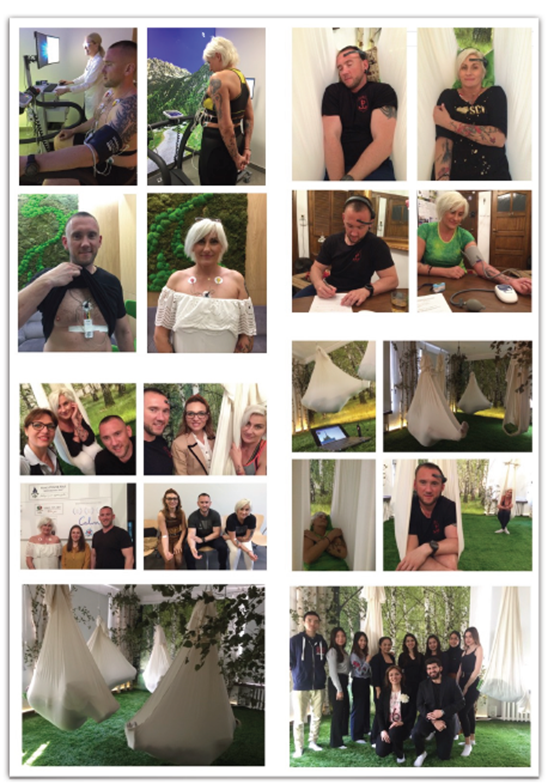
Picture 6: The picture of participants during the different phases of the research.
7. Research Results
“Subjects, during the research, participated in 20-minute VPN sessions, with 24 hours intervals in between. One or two VPN sessions were conducted per day for 10 consecutive days of research.
The groups of people participated in VPN sessions for the first time and only once, so it was shown their first impression and noticeable impact. No adverse events were reported” [73]. Second part of results of another parameters from this research are shown in previous author’s publication [73].
7.1 Environment parameters
The level of environmental parameters: temperature, humidity in the room and air temperature and pressure outside were measured (Figure 1). The air in the VPN room was purified from PM2,5, PM10, ionized and fragranced with smell of fresh cutting grass. Subjects were swinging in linen elastic cocoons with a small pillow under their head with body in ZGP. “The subjects noticed that on the 20th, 21st and 22nd of June they felt extremely well in the room during the VPN session. The humidity in the room was 81% on those days (higher than previous days) with a temperature of 24C (lower than before)” [73].
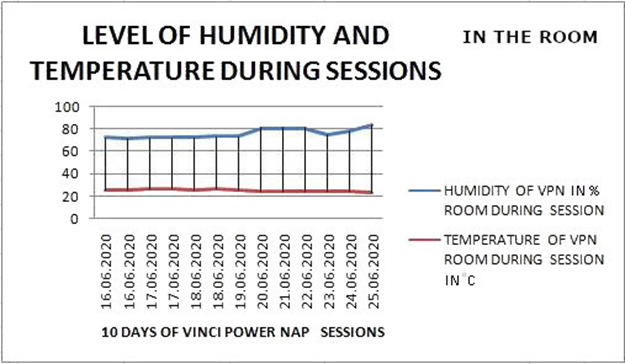
Figure 1: Level of temperature and humidity in the room during VPN sessions.
7.2 Measurement of selected parameters
The objective level of blood pressure, chosen hormones and other parameters, pulse, sleep, psychology tests of mood (anger, anxiety, fear, pain, overload of senes, frustration, social relations, trust, feeling of: love, calm, bliss, happy, regeneration, etc.) were measured from subjects before and after every session and also before the first and the final session with a two and four-week follow-up for some parameters with the subjective testimonials from subjects, to check the impact of neuroarchitecture of VPN system on human physiology and well-being. Comparing the levels of external atmospheric parameters (air temperature and air pressure outside the room) and their influence on the results on level of oxytocin on those days there is no relationship (Figure 3), but there is some good correlation between level of oxytocin and the humidity (81%) as well as temperature (24 C) in the room. (Figure 1 via Figure 4).
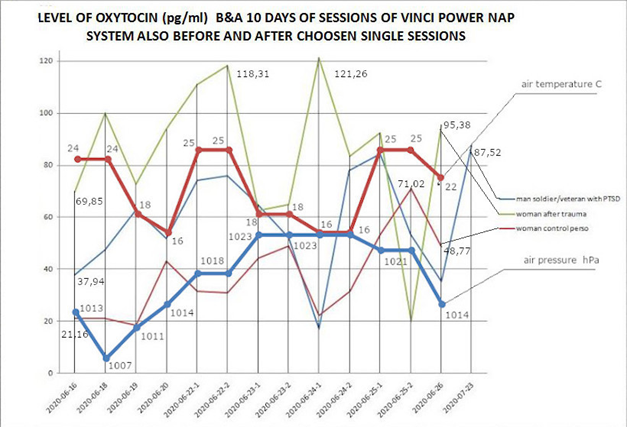
Figure 2: Level of oxytocin before and after VPN sessions comparing to air temperature and air pressure.
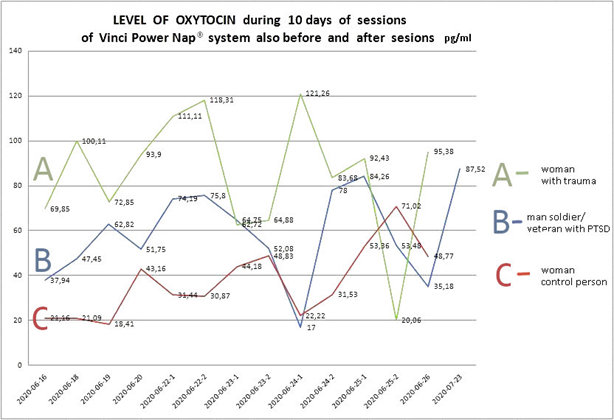
Figure 3: Level of oxytocin before and after VPN session.
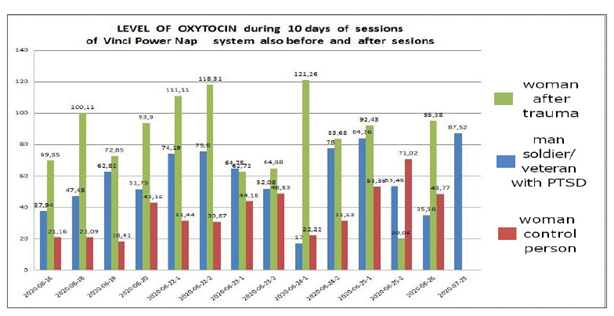
Figure 4: Level of oxytocin before and after VPN sessions during 10 days (for W, M, C) and after one month for M.
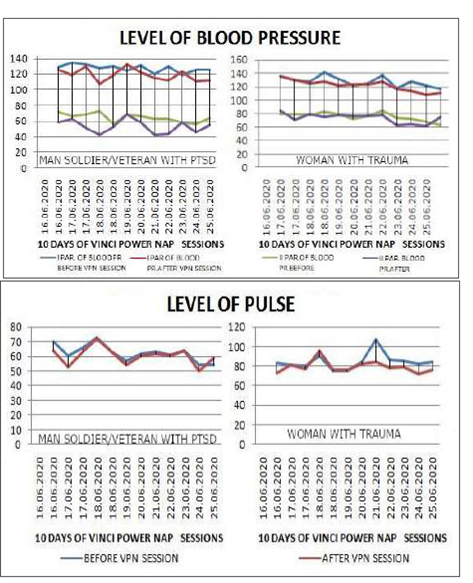
Figures 5, 6: Level of blood pressure and pulse before and after VPN sessions during 10 days of the resesrch.
Results show the rising level of oxytocin from 69,85pg/ml-95,38pg/ml for (W), from 37,94pg/ml-35,18pg/ml and after one month increasing to 87,52 for (M), from 21,16pg/ml-48,77pg/ml for control person (Figures 3 and 4). These are very important results, showing a prospect that it is discovery how to increase production in the brain the oxytocin and other hormones in natural way ( Figures 3, 4, 7,8, 9, 10, 11, 12, 13,14, 16, 17, 20, 21, 22), where until now the only one possibility was the synthetic hormones - which even could not cross the blood-brain barrier. The author considering the frequency of pressure on human skin in a VPN cocoon with embryonic life in the fetal waters and comparing it to the pulsating pressure on the skin of the fabric, author noted similarities with the pulsating rhythm of the mother’s blood pressure [73]. During labour, oxytocin is released in pulses from the pituitary into the circulation to induce uterine contractions. Maybe it is a reason why the level of oxytocin is very high for new born babies: 20-315 (69)pg/mL-po psn and 9-195 (33)pg/mLpo cc and it decreases fast in first 2 hours after birth, and even more after 4 days [137, 161]. Before and after sessions, also the pulsating touch on the skin of the VPN cocoon stimulates skin receptors, together with activation of the vagus nerve by swinging in ZGP, lead to observered re-ducing: stress, tension, high heart rate, pulse (70hb/s - 59 M), (83hb/s - 76 W) (Figure 6) and blood pressure by (141-109/ 85-62)mmHg for (W), (134-107/ 73-43)mmHg for (M) (Figure 5). It is related to the decrease in systemic vascular resistance and reduction of sympathetic nervous system activity during VPN sessions, which is key to bringing calmness and relaxation to mind and body, also balance hormones and neurotransmitters like oxytocin, vasopressin and others [106] (Figures from 7 to 16).
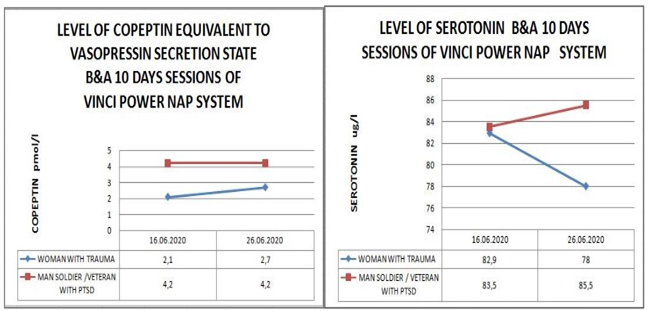
Figures 7, 8: Level of copeptin and serotonin before and after VPN sessions during 10 days of the experiment.
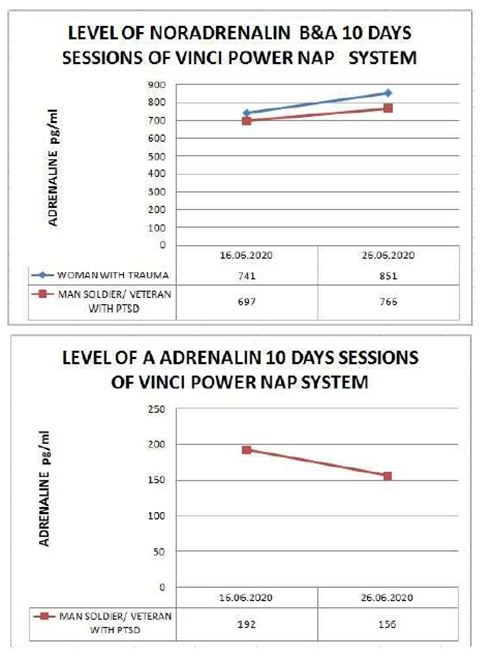
Figures 9, 10: Level of noradrenalin and adrenalin before and after VPN sessions during 10 days of the research.
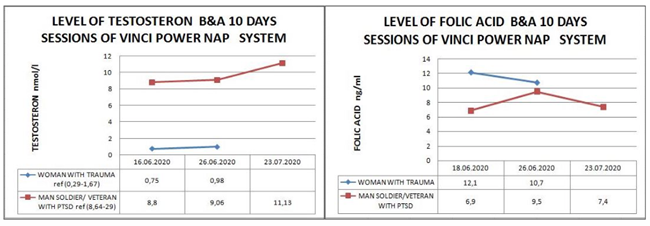
Figures 11, 12: Level of testosterone and folic acid before and after research of 10 days VPN sessions and after 1 month.
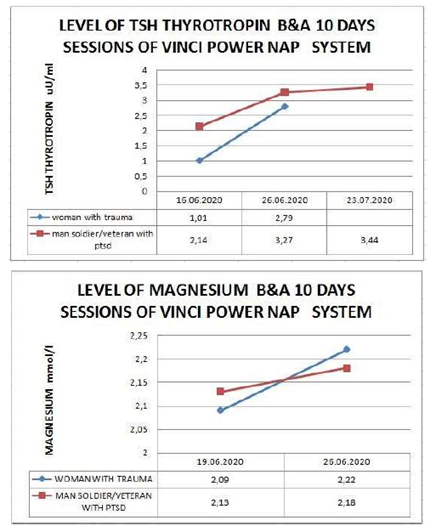
Figures 13, 14: Level of TSH and magnesium before and after research of 10 days VPN sessions and after 1 month.
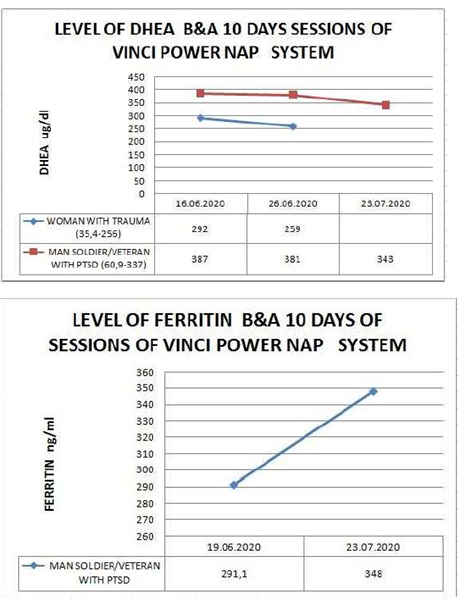
Figures 15, 16: Level of DHEA and ferritin before and after research of 10 days VPN sessions and after 1 month.
During and after 10 days of VPN sessions for subjects changing levels
Increases:
- Feeling calm and bliss (from 1-8 M), (2-10 W) (Figure 17)
- Sense of efficiency (10 const for M), (8 -10 for W) (Figure 21)
- Feeling acceptance, love, happiness (8-10W), (5 const for M) (Figure 20)
- Quality of sleep the night before (1-4 with 10 during the research for M), (1-4 with 8 during research for W) (Figure 22)
- Serum oxytocin (69,85pg/ml-95,38pg/ml W), (37,94pg/ml-35,18pg/ml and after one month increasing to 87,52 M), 21,16pg/ml-48,77pg/ml (C) (Figure 4)
- Serum prolactin (mlU/l) (180-257 M), (163-460 W)
- Serum dopamine (pg/ml) (150-211 M), (201-222 W)
- Serum testosterone (nmol/l) (8,8-9,06 M), (0,75-0,98 W) (Figure 11)
- Serum folic acid (ng/ml) (6,9-9,5 and 7,4 ng/ml M), (12,1-10,7 W) (Figure 12)
- Serum serotonin (ug/l) 83,5-85,5 for (M) (Figure 8)
- Serum copeptin (co/vasopressin) (pmol/l) (4,2-4,2 for M),2,1-2,7W) (Figure 7)
- Serum ferritin (ng/ml) (291,1-348 M) (Figure 16)
- Serum TSH (uU/ml) (1,01- 2,79 W), (2,14-3,27- 3,44 M) (Figure 13)
- Serum noradrenaline (pg/ml) (741-851 W), (697-766 M) (Figure 9)
- Serum adrenaline (pg/ml) (152-220 W) very stressful day for W (Figure 10)
- Serum magnesium (mmol/l) ( 2,09- 2,22 W) (2,13-2,18 M) (Figure 14)
Decrease:
- Anger and frustration (10 to 5 M), ( 6 to 1 for W) (Figure 18)
- Pain (10 to 7 M ), (10 to 1 for W) (Figure 19)
- Stress (10 to 6 for M), ( 10 to 1 for W)
- Pulse (hb/s) (70 - 59 M), (83 - 76 W) (Figure 6)
- Serum adrenaline (pg/ml) (192-156 M) (Figure 10)
- Serum DHEA (ug/dl) (292-259 W), (387-381 to 343 M) (Figure 15)
- Serum Serotonin (ug/l) (82,9-78 W) very stressful day for W (Figure 8)
- Folic acid (ng/ml) (12,1-10,7 W), (increase from 6,9-9,5-7,4 M) (Figure 12)
- Serum cortisol - in norm for W and M at 8.00: (norm 5 - 27 µg / dl) for W - 26.1, for M -16.3 at 12.00: (norm 4 - 20 µg / dl) for W - 12.6, for M- 4.02
Cortisol is one of the so-called stress hormones. Proper levels of cortisol in the body are important for the proper functioning of the immune system, as this hormone has antiinflammatory and immunesuppressive effects. In the case of cortisol concentration, the one-time test has little diagnostic value, which was observed during these studies also unfortunately because of misunderstanding with laboratory, therefore the results of its levels can not be interpreted. All those changes in hormones, together with stress reduction [162] and relaxation could be supportive for conception [105].
Results from the analysis of the surveys for ( M and W):

Figures 17, 18: Level of feeling calm, bliss/ anger and frustration before and after VPN sessions during 10 days of the research.
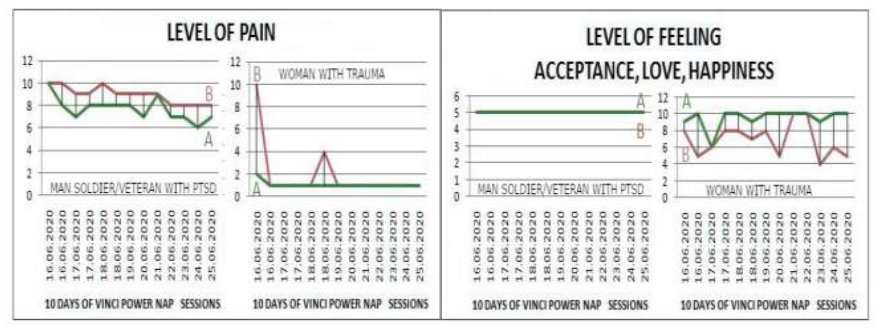
Figures 19, 20: Level of pain/ feeling acceptance, love, happiness before and after VPN sessions during 10 days of the research.
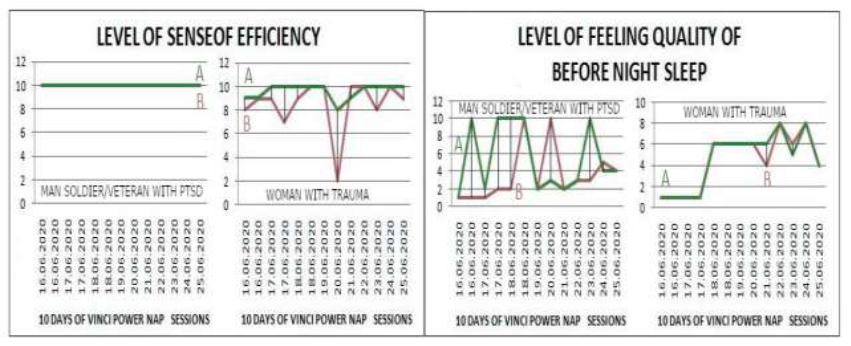
Figures 21, 22: Level of self-efficiency / quality of sleep night before, before and after VPN sessions during 10 days of the research.
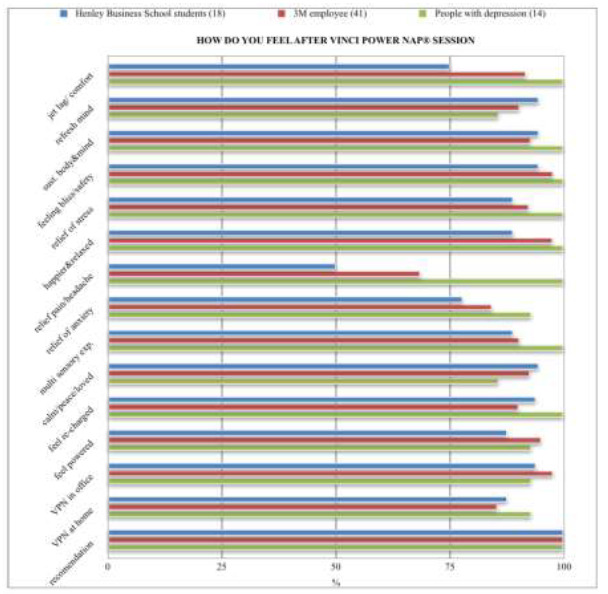
Figure 23: Results from survey after VPN session in the group of Henley Business School students (18), 3M employees (41), people with depression (14).
As reported by subjects experiencing deep relaxation during VPN sessions they had visions of loved ones and past positive experiences, fully engrossed in the memory through all of their senses. These sensations, along with both laughter and/or crying, can appear dur-ing session and are just some of the many ways of tension release, which as shown studies from The Trauma Centre it can help the healing process of trauma, so important especially for soldiers / VA. Relaxing in VPN cocoon allows one to „break away from time”, the basic dimension of our existence and to relax during this "space-time travel”. As Dr Michio Kaku is writing in „ Physics of the impossible”: ”according to the General Theory of Relativity, space and time are intertwined with each other, creating a kind of fabric that deforms under the weight of what lies on it”.
7.3 The psychologist’s comments on noticeable changes
Man soldier/veteran with PTSD - „Marked decrease: perceived anxiety and stress, sense of fatigue, pain, reaction to a sudden sound, the number of wake-ups at night and nightmares and tension in the body (outside the head). There was noticeable unblocking of the sense of smell, and taste.
There was also noticeably increased: feeling of relaxation, bliss and security, trust, waiting for pleasant situations, happiness during the day, "turning off the mind while swinging" cutting off sound stimuli, showing positive emotions, self-perceptible psycho-physical state. What should be also noted, the subject experienced the first night of undisturbed sleep since a very long time (2 full nights during the research in total).
Woman with trauma –„Significant decrease of: racing thoughts, the level of stress, fatigue and tension in the hands, powerlessness and senselessness, the number of waking up in the middle of the night, nightmares, pain. On the other hand, she exhibited an increased ability to be "here and now”, summon pleasant images from the past, "moments" of the feeling of lightness, weightlessness, being loved, accepted, peace of mind, balance, carefreeness, trust in people, tolerance for a smaller distance, joy during the day, self-felt psycho-physical state, sensitivity and sharpening of the sense of hearing”.
7.4 Participant’s final insight
7.4.1 Soldier with PTSD: “Vinci Power Nap® helped me relax temporarily and drift off, which improved my overall well-being and sleep levels. It gets better every day. It seems to me that I am attaining a better balance of life.”, „Almost two weeks of my stay in Wroclaw related to the everyday sessions of innovative VPN project, significantly changed my state of well-being and health. Thanks to a VPN, I was able to synchronize my thoughts with my body. The quality of my sleep has improved, thanks to which I function better on a daily basis, I fall asleep and wake up with fewer thoughts in my head. I have noticed that I am more sober and calmer. My heartbeat also slowed down. Overall I feel more relaxed. With each subsequent nap I had the impression of an additional impulse of peace and my thoughts. And the sleep - its change to '+', which continues even after one month”.
7.4.2 Woman with trauma: “I learned to distance myself from difficult situations, I can stop and be in the so-called "here and now", and can synchronize sensations from body with the work of the mind. I am relaxed, my eyes are rested, the headache and the tension in my hand and forearm have decreased, also noticeable in the handwriting (a revelation - I will buy a new pen), clearly the stress "comes off" from me, my body gains lightness, I feel weightlessness, I am calm "internally", there is no mental chaos, the sessions trigger nice memories in my head, moments when I felt happy”.
7.4.3 3M employees: “Super relax in the city center. Great thing especially after a long day of work. I fell asleep in minutes.”, “Thank you for the exceptional moments of sleep that I have never experienced before ... calm, without awakening and fear. An absolutely wonderful project - I wish you development so that it can help others.”, “Such a thing would be good for de-stressing at home, or at least at work. Comfortable, like a baby in a mother's womb. I recommend.”, “A great place, a brilliant idea.”, “A sleep cafe in the office would be handy.”, “Thank you for the beautiful experience of a moment of relaxation in the busy start of the week.”, “The wonderful lightness of being, the cocoon soothes and lifts above the earth, the body, the mind freely and lightly wanders through some pathlessness, somewhere beyond consciousness, place and time :)”, “I drifted away, at some point I lost the sense of time, place, the wonderful lightness of being”, “Feeling very energetic, relaxed, peaceful, charged, positive. Word are less to express my feelings”, “Life changing”.
7.4.4 Students Henley Business School: “The experience was wonderful. Loved it! Thank you!”, „Just a lovely experience. Very safe feeling”.
7.4.5 Keith Heron professor from Henley Business School UK - the teacher: “20 Feb 2019…although I was completely unaware of the day or time….after a few minutes I was completely relaxed. My minor stroke from stress may have been avoided if this wonderful sensation had been available. Magda is a wonderful person with huge technical and intuitive insights. What great design...what huge potential benefits.” 18 October 2019: ”…again…wonderful. How can we help Magda to populate the world with this fantastic innovation...Help is needed to distribute these benefits!” More testimonials on website linked to this reference [163].
7.4.6 People with depression: “Soothing bliss and rest from the world outside the window”, "A very pleasant "stopping" experience in the course of everyday life”, “It was a great experience smell, light, feeling of grass, great for the senses, a brilliant feeling of regeneration”.
8. Conclusions
Albert Einstein said: “Intellectuals solve problems, geniuses prevent them”. This pilot study shows that this interdisciplinary, revolution technology of neuroarchitecture system has a significant impact on the human's physiology and psychology, in innovative way using evolutionary biological, basic physical principles and recently published neuroscientific studies - confirms human's well-being depends on many factors, but especially of their surrounding environment [16, 164].
Psychoneuroimmunology of Vinci Power Nap® system and its unique combination of: touch, simulating microgravity and hypergravity through its pendulum swinging movement (with natural frequency and gravitation of Earth together with space technology of Zero Gravity Position), sense-soothing neuroarchitecture of nature environment, free from pollution, allowing for quick 15-20 minutes regenerative power naps - could help to harmonize person, de-link the emotional experience of trauma and reconnect the body with the mind. Its neuroarchitecture relaxation system can leads to increasing health, satisfaction and efficiency of life, maintain high productivity and performance, can be significant support for: business leaders, employees, doctors, patients, rescue servicemen, teachers, students, scientists, children, parents, drivers, soldiers, pilots, astronauts [165, 166], veterans and persons who suffered various forms of loss, etc. helping to restore and rediscover inner balance that is so easily lost in everyday life.
This study provides the basis for assessing the effectiveness and benefits of the VPN revolutionary system, and its responsibility for helping people to improve psychosomatic dialogue, regarding well-being of humankind on Earth and in the Space. Besides of bringing feeling of calmness, safety, bliss, love, acceptance, improving immune system, as well as by overall relax, by decreasing exposure to specific environmental somatosensory triggers could also reduces: stress, tension, anxiety, anger, pain, likely cancer cell counts and optimized the physiological balance of: respiratory frequency, heart rate and heart rate variability (HRV) [73], blood pressure, neurotransmitters and hormones like: oxytocin, serotonin, dopamine, copeptine, TSH, prolactin, testosterone, adrenaline, cortisol. Self activated diaphragmatic breathing stimulating vagus nerve (and parasympathetic nervous system, inducting also raising heart rate variability (HRV) and serotonin transport from the gut to the brain [167].
Moreover VPN can improve: brain deep relaxation together with endorphin-producing activities boosting the mood, emotional stability, night sleep, memory and learning, focus, creativity, productivity, happiness, self-confidence, ability to introspect, openness to physical contact, restored faith, hope, refresh energy, bringing rejuvenation and longevity. By its suppressing the „fight, flight or freezing” mechanism, allow the body and mind to reset, create its positive functional reconnectivity, as subjects report: "VPN restores me to factory settings”. By highlighting the role of oxytocin in the regulation of 5-HTP signaling, this study findings can lead to novel therapeutic strategies for mental and physical disorders VPN can be used as help in the treatment: sensory overload (SPD), trauma, depression, anxiety, post-traumatic stress disorder (PTSD), social anxiety, obsessive-compulsive disorder (OCD) (also bulimia, anorexia) [168] and sleep disorders (insomnia, parasomnias), addictions (including alcohol misuse), pathological anger, chronic fatigue syndrome (CFS), bipolar disorder, attention deficit, hyperactivity disorder (ADHD) [169], schizophrenia [170], Autism spectrum disorder (ASD), Asperger syndrome [171], Alzheimer’s Disease (Tokyo University of Science [172]) and Parkinson’s Disease [173] as it could relieve some conditions. VPN can be helpful in treatment of: diabetes, insulin resistance, cancer and others illnesses; supporting people to cope with their symptoms and emotional connection with it - therefore improve their quality of life during the illness, also can be great for the care of bedridden patients (e.g.Covid-19 and their families), as microgravity helps in wound healing as well as rocking and oscillating pressure promotes the movement of lymph, cleansing the body of bacteria and damaged cells. It can also help heal bedsores - there are no pressure points in the VPN’s cocoon. Moreover the healing properties of the green architecture have already been recognized around the world following the example: „Design Firm Was Asked To Create A Hospital That Lowers Blood Pressure And Built A 'Forest-Like' Sanctuary” [174].
VPN can be an effective way to support work with children suffering from emotional distress and problems with concentration [175, 176] at schools and a great solution at orphanages, helping shape positive outcomes. Going further, the author wonders whether it can be also used as a calming method for incarcerated prisoners, to give them a sense of acceptance ("silent understanding"), rise "social hormones" by its cocoon's hug and thus aid re-socialization. It reflects our commitments to understand and nurture the bond that connects people, society and habitats and to find the new paths for prosperity that can lead to a viable, more sustainable future. VPN sessions can also be the aid for those trapped by their own traumatic experiences ( also military), “the U.S. Department of Veterans Affairs is looking for helpful treatment for PTSD all the time as getting better treatments to these patients faster would be lifesaving” [177]. The revolutionary Vinci Power Nap® could acts as a tool for stress management during pre-flight training, on the mission itself and afterwards, as it is beneficial not only for human regeneration in smart cities but also on space missions [73, 178] as a antidepressant treatments which are effective, rapid acting, safe, and tolerable are necessitate [179].
This pioneering interdisciplinary study (research) work is rele-vant, because it turns out things are coupled to each other in a way which never would be seen if didn’t measure simultaneously: blood, heart beat, frequency of swinging pendulum and electrical activity of brain (part of its shown in [73]) together with psychological feedbacks. It expands the knowledge of neurophysiological mechanisms in the important role of regulating the autonomic nervous system affecting better sleep, mood and health, together with opening up new perspectives for understanding ways to heal the pathological conditions associated with abnormal sleep patterns, which involve multiple systems [176, 180]. This work follows a similar approach to the unified physics approach, which is essentially a scale invariant model from the quantum to the biological and the cosmological scale.
Proper regeneration is a means of prevention for various mood and health disorders, that is why it should be a priority in smart cities, creating a place that effectively eliminates or lower stressful conditions, incorporating and maintaining sustainable harmony between implementing technological advancements to facilitate life and respecting the balance from our planet’s designed ecosystem [181-183]. Innovative neuroarchitecture technology on the example of Vinci Power Nap® is the combination of art and science and is creating physical, psychological, behavioral, emotional benefits for humankind.
Vinci Power Nap® won top award “Quality Wellbing Certificate 2019” from Wellbeing Institute, as noninvasive brain/body reconnection method, allowing better manage stressful life situations, which has been approved by prof. Philip Zimbardo from Stanford University, Prof. Micha? Jedrzejewski from Academia of Fine Arts, Artur Chmielewski Project Manager at NASA JPL, Top 500 Innovators, Roman Juchnevic President of Association of Heads of Pedagogical-Psychological Teams of Lithuania, various sleep experts such as: Dr Vats Mayank, Dr Michal Skalski, Prof. Vincent Walsh, Nancy H. Rohstein (Sleep Ambassador), Nick Littlehales, cardiologist Dr Ewa Sokola-Wysoczanska, several Ministries, the UN Cli-mate Change Secretariat, National Institute of Silver Economy, soldiers and veterans from the US Army and the Polish Army, pilots, as well as recognition of patients and therapists from the Psychiatric Clinic and many more [185].
"Mental health is at the core of our humanity. As we recover from the pandemic, we must take the opportunity to build mental health services for the future (…). It will be essential to involve people with lived experience of mental health conditions in designing and delivering services. There is no health without mental health (…). Mental health services are an essential part of all government responses to COVID-19. They must be expanded and fully funded. (…)” Antonio Guterres the Secretary-General of the United Nations 21.05. 2020 [184].
“Magda – You have created a unique sensory environment that enabled me totally relax, sleep deeply and awake fully refreshed after only 26 magic minutes (…) Your idea must be translated into a global movement that helps everyone – young and old to unite mind, heart, spirit and body.” Ph.D. Philip Zimbardo San Francisco / Stanford University 23.05.2019 [185].
“(…) We are most grateful for Ms.Filcek’s VPN initiative (of restorative value of the peaceful interlude in an otherwise hectic conference period), and hope that she will be able to have similar impact on other conference participants in future events. “Laura Lopez Director Conference Affairs Services. United Nations Climate Change Secretariat 11.03.2019 [185].
“You are a genius and I'm proud to know you. NASA work's well because we have people like you. You are an honorary NASA employee. I love your concept and I hope that soon we will open your dreams cafe in all NASA Centres”. Art B. Chmielewski Caltech / NASA JPL Project Manager 20.05.2019 about Magdalena Filcek [185]. Today we are charging our phones and cars, do not forget to recharge ourselves with sleep and nap in the best environmental conditions.
References
- Donahue JJ, et al. Fight-Flight-Freeze System. Encyclopedia of Personality and Individual Differences: 1590-1595.
- Berger JM, et al. Mediation of the Acute Stress Response by the Skeleton (2019).
- Ranabir S, et al. Stress and hormones (2011).
- Antonovsky A. A somewhat personal odyssey in studying the stress process (1990).
- Maintz L, Novak N. Histamine and histamine intolerance (2007).
- Reiche EMV, et al. Stress, depression, the immune system, and cancer. The Lancet Oncology (2004).
- Mariotti A. The effects of chronic stress on health: new insights into the molecular mechanisms of brain–body communication (2015).
- Source: National Alliance on Mental Illness.
- Extent and Health Consequences of Chronic Sleep Loss and Sleep Disorders. Chapter of Sleep Disorders and Sleep Deprivation An Unmet Public Health Problem. Washington (DC): National Academies Press (US) (2006).
- Tin FH. Psycho-physiological Measures of Situation Awareness. Book (2007).
- McFarlane A. The long-term costs of traumatic stress: intertwined physical and psychological consequences (2010).
- Antonovsky A. Unraveling the mystery of health: How people manage stress and stay well (1987).
- Akin C, Metcalfe DD. Mastocytosis and mast cell activation syndromes presenting as anaphylaxis (2011): 245-256.
- Gordan R, et al. Autonomic and endocrine control of cardiovascular function (2015).
- Jedrzejewski M. Wnetrze jako informacja wizualna. Panstwowa Wyzsza Szkola Szyuk Plastycznych Wroclaw (1976).
- Hand E. Maverick scientist thinks he has discovered a magnetic sixth sense in humans (2016).
- 5 Sensory and Motor Pathways.
- Molecular Cell Biology. 4th edition. Section 21.4. Neurotransmitters, Synapses, and Impulse Transmission (220).
- Kragel PA, et al. Somatosensory Representations Link the Perception of Emotional Expressions and Sensory Experience (2016).
- Zimmerman M. The nervous system in the context of information theory. Springer (1989).
- Rouby C, et al. The Role of the Senses in Emotion (2016).
- Rautio N, et al. Living environment and its relationship to depressive mood: A systematic review (2017).
- Bullinger M. Environmental Stress: Effects of Air Pollution on Mood, Neuropsychological Function and Physical State. Psychobiology of Stress 241-250.
- Dzhambov AM, Dimitrova DD. Urban green spaces effective-ness as a psychological buffer for the negative health impact of noise pollution: A systematic review (2014).
- Bedrosian TA, Nelson RJ, Timing of light exposure affects mood and brain circuits (2017).
- Electromagnetic fields and public health (2006).
- Human Research Program Behavioral Health and Performance Element (2016).
- Watkins T, CNN. Researchers urge doctors to disclose sleep fatigue before surgery (2010).
- The National Transportation Safety Board (2022).
- Huffington A. The Sleep Revolution (2019): 40.
- St-Onge MP, et al. Sleep Duration and Quality: Impact on Life-style Behaviors and Cardiometabolic Health. A Scientific Statement From the American Heart Association (2016).
- Rudolph KL. Longevity, Stress Response, and Cancer in Aging Telomerase-Deficient Mice (1999).
- Neri D. Sleep, Circadian Rhythms, and Performance During Space Shuttle Missions. NASA (2003).
- Basedovsky L, et al. Sleep and immune function (2012).
- The AASM Manual for the Scoring of Sleep and Associated Events.
- Nutt D, et al. Sleep disorders as core symptoms of depression (2008).
- Carney CE, et al. Cognitive Behavioral Insomnia Therapy for Those With Insomnia and Depression: A Randomized Controlled Clinical Trial (2017).
- Nishida M, Walker MP. Daytime Naps, Motor Memory Consolidation and Regionally Specific Sleep Spindles (2007).
- Armitage R, et al. Slow-wave activity in NREM sleep: sex and age effects in depressed outpatients and healthy controls. Psychiatry Research (2000).
- Colrain IM, et al. Impact of Alcoholism on Sleep Architecture and EEG Power Spectra in Men and Women (2009).
- Zienkiewicz A, Szopa M, et al. Combat related post-traumatic stress disorder - causes, symptoms and consequences. Journal of Science. Military Academy of Land Forces 48 (2016).
- Abdelkarim TH, et al. Presence of delta waves in REM sleep during polysomnography as a sign of acute hypoglycemic encephalopathy. Sleep (2002).
- Walker MP, et al. Sleep, memory, and plasticity (2000).
- Smulders FT, et al. The effects of sleep loss on task performance and the electroencephalogram in young and elderly subjects. Biological psychology (1997).
- Fultz NE. Coupled electrophysiological, hemodynamic, and cerebrospinal fluid oscillations in human sleep (2019).
- Cole EJ, et al. Stanford Accelerated Intelligent Neuromodulation Therapy for Treatment-Resistant Depression (2020).
- Cairney SA, et al. Targeted Memory Reactivation During Slow Wave Sleep Facilitates Emotional Memory Consolidation. Sleep (2014).
- Colrain IM, et al. Sleep evoked delta frequency responses show a linear decline in amplitude across the adult lifespan. Neurobiology of Aging (2008).
- Walker MP. Sleep-Dependent Memory Processing. Harvard Rev.of Psych (2007).
- Eugene AR, Masiak J. The Neuroprotective Aspects of Sleep (2015).
- Kishi A, et al. Sleep-Stage Dynamics in Patients with Chronic Fatigue Syndrome with or without Fibromyalgia (2011).
- Sherin JE, et al. Post-traumatic stress disorder: the neurobiological impact of psychological trauma (2011).
- Baglioni C, et al. Clinical implications of the causal relationship between insomnia and depression: how individually tailored treatment of sleeping difficulties could prevent the onset of depression (2011).
- Reif J, et al. Dealing With Stress in a Modern Work Environment (2021).
- Feeling Well Rested and Wide Awake When it Counts (2006).
- Rosekind MR, et al. Crew Factorsin Flight Operations IX: Ef-ects of Planned Cockpit Reston Crew Performance and Alertness in Long-Haul Operations (1994).
- Naska A, et al. Siesta in healthy adults and coronary mortality in the general population (2007).
- Sleepfoundation (2020).
- Littlehales N. Sleep (2016).
- Hall A. The Energy Secret These 15 Successful People Swear By (2017).
- Soojung-Kim Pang A. Rest - when you get more done when you work less (2016/2018).
- Achimowicz JZ. On the Biophysical Models of Consciousness and Situation Awareness of Pilots/Astronauts and Implications for Flight Safety (2019).
- (Bud) Craig AD. Interoception: the sense of the physiological condition of the body (2003).
- Anema HA, et al. A double dissociation between somatosensory processing for perception and action. Neuropsychologia 4 (2009): 1615-1620.
- Filcek M. The Vinci Power Nap® - Reconnect System – Neuroarchitecture of Interior Design Creating Environment for Regenerating Body and Mind, Helping Inhabitants of Smart Cities and Astronauts with Stress Reduction, Depression, PTSD, Improving Efficiency, Sleep, Health and Quality of Life. Ierek FSC (2019).
- Gelb MJ. Myslec jak Leonardo da Vinci. Poznan (2019).
- Kompotis K. Rocking Promotes Sleep in Mice through Rhythmic Stimulation of the Vestibular System (2019). Perrault AA. Whole-Night Continuous Rocking Entrains Spontaneous Neural Oscillations with Benefits for Sleep and Memory (2019).
- Cardaioli M. Equilibrioception: a method to evaluate the sense of balance (2017).
- Paul M. Rhythm of Breathing Affects Memory and Fear. Northwest Univ (2016).
- EMDR therapy (2022).
- Kawli T, et al. It takes nerves to fight infections: insights on neuroimmune interactions from C. elegans (2010).
- Zero Gravity Position Explained (2009).
- Filcek M. Cutting edge solution for effective and safe missions - neuroarchitecture system of Vinci Power Nap® - revolution in fast stress reduction, regeneration, regenerating body and mind, which can help you, pilots, astronauts: before, during and after space travels. 71st International Astronautical Congress (IAC) – The CyberSpace Edition (2020).
- Bratma GN. et al. Nature and mental health: An ecosystem service perspective (2019).
- Porges SW. Neuroception - a Subconscious System for Detecting Threats and Safety (2004).
- Gibson S. Controlled Vestibular Stimulation: A Physiological Method of Stress Relief (2017).
- The Overview Effect (2012).
- NASA Moldofsky. Microgravity, Sleep/Wake Immune Functions (SWIF) in Humans (9401710) (1997-1998).
- Kiecolt-Glaser JK. Psychoneuroimmunology Psychologys Gateway to the Biomedical Future (2009).
- Jessen NA. The Glymphatic System: A Beginners Guide. Neurochem Res (2015).
- Wiig H, Swartz MA. Interstitial fluid and lymph formation and transport: Physiological regulation and roles in inflammation and cancer (2012).
- The lymphatic system how to improve it natural recommendations. Natural ways of lymphangitis (1932).
- hydrotherapy-by-pradeep (2015).
- Williams M. Microgravity Seems to Neutralise The Majority of Cancer Cells, Experiments Reveal (2019).
- Fighting Cancer with Microgravity Research (2013).
- Zero gravity kills cancer cells (2019).
- Holman J. Space the new frontier in the battle against cancer (2019).
- Studenci z Wroclawia jako pierwsi zbadaj? komórki nowotworowe w hipergrawitacji (2018).
- Turner KA. Radical Remission Author Dr. Kelly Turner on Key Factors for Cancer Patients.
- Dr David Servan-Schreiber. Anticancer, a new way of life. Antyrak (2011): 197.
- Shanker S. Self-Reg. Warszawa (2016).
- Zimbardo PG, et al. Psychologia Kluczowe koncepcje, podstawy psychologii (2017).
- Lange T. et al. Effects of sleep and circadian rhythm on the human immune system (2010).
- Murphy MLM, et al. Receiving a hug is associated with the attenuation of negative mood that occurs on days with interpersonal conflict (2018).
- Stoop R. Neuromodulation by oxytocin and vasopressin in the central nervous system as a basis for their rapid behavioral effects (2014).
- Churchland P, et al. Modulating social behavior with oxytocin: how does it work? What does it mean (2012).
- Kubzansky LD. A heartfelt response: Oxytocin effects on response to social stress in men and women. Biological Psychology (2012).
- Uvnäs Moberg K. Oxytocin: the biological guide to mother-hood. Amarillo Press (2014).
- Szydlik P. Oksytocyna – kompendium wiedzy (2020).
- Li T, et al. Approaches Mediating Oxytocin Regulation of the Immune System (2017).
- Kendrick KM. Oxytocin, motherhood and bonding” Experim. Psychology (2005).
- Babygirija R. et al. Central oxytocin is involved in restoring impaired gastric motility following repeated stress in mice. J.Phys. Regul. Integr. Comp. Physiol (2009).
- Magon N, et al. The orgasmic history of oxytocin: Love, lust, and labor (2011).
- Seltzer LJ, et al. Social vocalizations can release oxytocin in humans. RS (2010).
- Thackare H, et al. Oxytocin-its role in male reproduction and new potential therapeutic uses. Human Reproduction Update (2006).
- Rinaman LL, et al. Vasopressin and oxytocin in the control nervous system (1995).
- Daily Health Post Editorial. New Study: The More you Hug your Kids, the More Their Brains Develop (2019). Sohal VS. Serotonin Gives Oxytocin a Helping Hand. Neuroscience Sc (2013).
- Sideris IG, et al. Amniotic fluid pressure during pregnancy (1990).
- Bright FM, et al. Medullary Serotonin Neuron Abnormalities in an Australian Cohort of Sudden Infant Death Syndrome. Journal of Neuropathology and Experimental Neurology (2017).
- Ledford H. Cot death victims make less serotonin. Nature (2010).
- Wolfe J. Frédérick Leboyer, Who Saw Childbirth Through Baby’s Eyes, Dies at 98. TNYT (2017).
- Uvnäs- Moberg K. Maternal plasma levels of oxytocin during physiological childbirth - a systematic review with implications for uterine contractions and central actions of oxytocin (2019).
- Widstrom AM, et al. Newborn behaviour to locate the breast when skin-to-skin: a possible method for enabling early self-regulation. Acta Paediatr (2011)
- Eaton JL, et al. Organizational effects of oxytocin on serotonin innervation. Dev Psychobiol (2011).
- Kirsch P, et al. Oxytocin modulates neural circuitry for social cognition and fear in humans. J. Neurosci (2005).
- Slezak M. Rats can't get drunk after a dose of oxytocin hormone. Health (2015).
- Stein BE. The neural basis of multisensory integration in the midbrain: Its organization and maturation (2009).
- Essential Guide To Serotonin And The Other Happy Hormones In Your Body.
- Palma –Gudiel H, et al. An integrative review of methylation at the serotonin transporter gene and its dialogue with environmental risk factors, psychopathology and 5-HTTLPR (2016).
- Fernandez IO, et al. Oxytocin and autism: a hypothesis to research. Can perinatal oxitocinergic manipulation facilitate autism? (2011).
- Parker K. Study shows which children with autism respond best to oxytocin treatment (2017).
- Taylor E, et al. Child and adolescent psychiatry” Oxford: Bla. Sci 162 (2013).
- Untuk Pilih Buaian Bayi & Katil Bayi Yang Sesuai Buat Si Comel, Tak Pening Lagi Kepala! hellodoktor.com (2020).
- pl (2020).
- Maitre NL, et al. The Dual Nature of Early-Life Experience on Somatosensory Processing in the Human Infant Brain (2017).
- Hamilton J. Orphans Lonely Beginnings Reveal How Parents Shape A Child's Brain (2014).
- Kol YH, et al. Whole body vibration analysis of baby hammock (2018).
- Sripada CS, et al. Oxytocin enhances resting-state connectivity between amygdala and medial frontal cortex. J. Neuropsychopharmacol (2012).
- Mottolese R. et al. Switching brain serotonin with oxytocin. Neuroscien (2014).
- Brummelte S, et al. Developmental changes in serotonin signaling: implications for early brain function, behavior and adaptation. Neuroscience (2017).
- Lucki II. The spectrum of behaviors influenced by serotonin. Biol Psych (1998).
- Mental Health and Sleep (2020).
- Sleep/Wake Cycles (2022).
- Hand E. Maverick scientist thinks he has discovered a magnetic sixth sense in humans (2016).
- Wilson BW, et al. Evidence for an Effect of ELF Electromagnetic Fields on Human Pineal Gland Function Journal of Pineal (1990).
- Neil Cherry Dr. EMF/EMR Reduces Melatonin in Animals and People (2002).
- van Der Kolk BA. Dissociation and the fragmentary nature of traumatic memories: Overview and exploratory study (1995).
- Izard CE. Paterns of emotions. A new analysis of anxiety and depression. New York/ London (1972).
- The Complex Relationship Between Sleep, Depression and Anxiety. Sleepfoundation.org (2020).
- Carey B. Sleep Therapy Seen as an Aid for Depression (2013).
- Armitage R. Slow-wave activity in NREM sleep: sex and age effects in depressed outpatients and healthy controls. Psychiatry Research (2000).
- Cole Ej, ot. Stanford Accelerated Intelligent Neuromodulation Therapy for Treatment-Resistant Depression (2020).
- Nutt D , ot. Sleep disorders as core symptoms of depression (2008).
- Management of Post-Traumatic Stress Working Group. VA/DoD Clinical Practice Guideline for the Management of Post-Traumatic Stress. Washington D.C.: Department of Veterans Affairs and Department of Defense (2010).
- Zienkiewicz A, Szopa M, ot. Combat related post-traumatic stress disorder - causes, symptoms and consequences. Journal of Science. Military Academy of Land Forces 48 (2016).
- Sherin JE , ot. Post-traumatic stress disorder: the neurobiological impact of psychological trauma (2011).
- Cairney SA, ot. Targeted Memory Reactivation During Slow Wave Sleep Facilitates Emotional Memory Consolidation. Sleep (2014).
- Nishida M, Walker MP. Daytime Naps, Motor Memory Consolidation and Regionally Specific Sleep Spindles (2007).
- Colrain IM, ot. Impact of Alcoholism on Sleep Architecture and EEG Power Spectra in Men and Women (2009).
- Robert Stickgold, ot. Sleep-Induced Changes in Associative Memory. Journal of Cognitive Neuroscience (1999).
- Wamsley EJ, ot. Memory, Sleep and Dreaming: Experiencing Consolidation (2012).
- Strach ucielesniony. Bessel Van Der Kolk str 340 Warszawa (2019).
- Tips for Relaxation (2018).
- Department of Veterans Affairs. How common is PTSD? (2015).
- Drugie zycie naznaczonych - historia zolnierza z PTSD (2012).
- Pigeon WR. The Relationship of Suicidal Thoughts and Behaviors to Sleep Disturbance: a Review of Recent Findings (2016).
- Source National Alliance on Mental Illness: www.nami.org
- Department of Veterans Affairs. US. Depart. of Defense. VA/DoD clinical practice guideline for assessment and man-agement of patients at risk for suicide (2103).
- Tanielian T, ot. Invisible Wounds of War: Psychological and Cognitive Injuries, Their Consequences, and Services to Assist Recovery. RAND Corporation (2008).
- Reisman M. PTSD Treatment for Veterans: What’s Working, What’s New, and What’s Next (2016).
- Puskarz-Gasowska J. Noworodek z porodu indukowanego (2008).
- Marzony ET. Relationship of oxidative stress with male infertility in sulfur mustard-exposed injuries (2016).
- Innovative Vinci Power Nap® (2022).
- Committee on NASA’s Research on Human Health Risk. Re-view of NASA’s Human Research Program Evidence Books. A Letter Report (2008).
- Douglas W. Human performance issues arising from manned space station missions. NASA (1986).
- Hadfield C. An astronaut’s guide to life on earth. London (2015).
- Bergland C. The Vagus Nerve May Carry Serotonin Along the Gut-Brain Axis (2019).
- Atasoy D, et al. Deconstruction of a neural circuit for hunger (2012).
- Demirci E, et al. Relationship between Impulsivity and Serum Oxytocin in Male Children and Adolescents with Attention-Deficit and Hyperactivity Disorder: A Preliminary Study (2016).
- Wessel L. Out-of-Sync Brain Waves May Underlie Learning Deficit Linked to Schizophrenia (2020).
- Romano A, et al. From autism to eating disorders and more: the role of oxytocin in neuropsychiatric disorders. Front Neurosci (2016).
- Tokyo University of Science. Love hormone oxytocin could be used to treat cognitive disorders like Alzheimers (2020).
- Landhuis E. Ultrasound for the brain. Wu Tsai Neurosciences Institute Stanford Neurosciences (2017).
- Katerina P. Design Firm Was Asked To Create A Hospital That Lowers Blood Pressure And Built A 'Forest-Like' Sanctuary (2019).
- Masgutova S, Kowal J. Neurokinesiology Tactile Therapy by Dr. S. Masgutova. International Conference Materials: Modern Methods of Stimulation of Motor and Language Development. MINK, Warsaw 2.
- Perrault AA, et al. Whole-Night Continuous Rocking Entrains Spontaneous Neural Oscillations with Benefits for Sleep and Memory. Current Biology (2019).
- Tanielian T, et al. Invisible Wounds of War: Psychological and Cognitive Injuries, Their Consequences, and Services to Assist Recovery. RAND Corporation (2008).
- Lewin S. Landmark NASA Twins Study Reveals Space Travel's Effects on the Human Body (2019).
- Depression (major depressive disorder (2021).
- NASA: Boyle R, Reschke MF, George K, et al. Challenges to the central nervous system during human spaceflight missions to Mars (2020): 14, 15.
- Sleep Education Archive. Sleep in the city: big-city living may cause insomnia, sleep loss (2008).
- Stevenson book S. Sleep Smarter : 21 Essential Strategies to Sleep Your Way to a Better Body, Better Health, and Bigger Success (2014).
- Winer E. Design on the brain: Combining neuroscience and architecture (2018).
- Guteres A. We Need to Take Action to Address the Mental Health Crisis in This Pandemic (2020).
